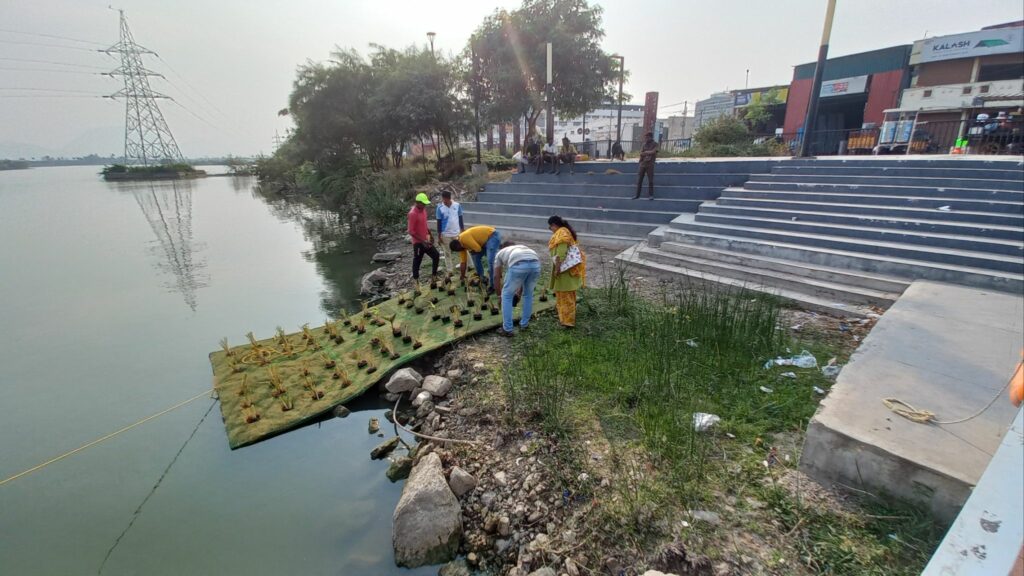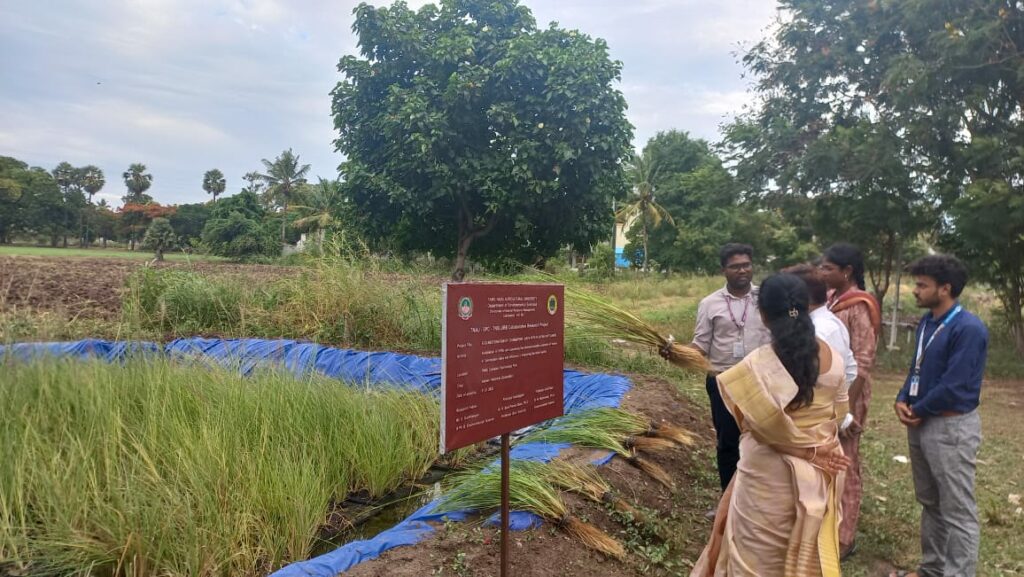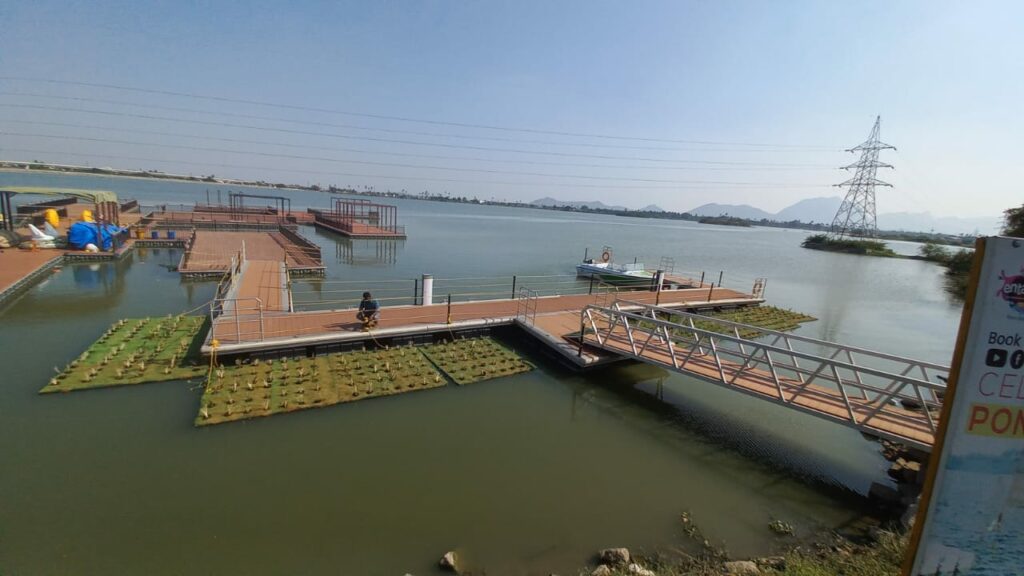 Vetiver floats in Ukkadam lake; photo by Sara Parwin
Vetiver floats in Ukkadam lake; photo by Sara Parwin
A fragrant plant traditionally used in India in perfumery, traditional medicine and as a natural cooling agent has found a new role helping to combat the effects of climate change. A casual conversation between a professor and her students led to vetiver grass (chrysopogon zizanioides) being tested by a team of Indian scientists for its efficacy in treating waste water. It proved so successful that they have now patented their treatment method. Their specially designed “grass floats” are already spreading across India’s urban areas, helping to clean up dangerously polluted waterways.
Vetiver grass is a perennial plant with remarkable resilience, thriving in extreme conditions, including drought and even in heavily polluted environments. According to the scientists, vetiver’s deep and dense root system allows it to absorb contaminants from within waste water, making it a highly efficient, sustainable and low-cost way to remove pollutants. Although vetiver is recognized globally for its soil erosion control capabilities, the grass is now gaining attention for its ability to mitigate the impacts of industrial effluents, municipal sewage, and landfill runoff.
Professor Sara Parwin Kamaludheen and her students at Tamil Nadu Agricultural University (TNAU) in Coimbatore city in southern India, have championed the use of Vetiver grass as a game-changer in climate-adaptive water treatment solutions. They have designed a float that carries the vetiver grass while it grows, enabling it to absorb heavy metal components from any body of contaminated water. Professor Sara and her students have demonstrated that vetiver grass can remove heavy metals such as zinc, lead, and chromium.

Professor Sara’s journey began eight years ago when she and her students attended a national conference on vetiver grass, which led to the formation of a transformative research project.
Vignesh Kumar now works in Tamil Nadu’s Climate Change Mission but he was a student of Professor Sara’s at the time. Working on the vetiver research project inspired him to focus his work on developing cost-effective, sustainable solutions for climate change-related challenges. ”We shaped the idea to design a vetiver float during a casual chat. When Professor Sara asked for a suggestion from us to identify a plant that could be tried out for effluent treatment, I mentioned vetiver. Since vetiver has a dense root network, I thought it would effectively withstand contamination. The casual chat turned into my dream project!” he explained.
This in turn led to the development of today’s vetiver floats, an eco-friendly innovation designed to treat wastewater and combat climate-related water pollution. These floats have been tested in controlled experiments in lakes and wastewater treatment facilities across Tamil Nadu state, where they not only proved highly effective at removing pollutants, but over the 16-month trial period they also improved biodiversity by restoring aquatic life. After three months, the grass floats can be replaced with new ones and any grown roots can be used to produce handicrafts and for other non-edible purposes.

Scaling the research up further, the research team also ventured into testing the grass in effluent water in the dyeing industry. M. Aarthy and G. Karthikeyan, two students who contributed to this second stage, explained, “We used the same float design for our study. We placed the floats in tertiary waste water from the dyeing industry. We realised vetiver plants are resistant to the contaminants in polluted water and possess greater efficiency in the remediation of dyeing effluents. We have published our research findings in various science journals. We received good responses not only from scientists but also from industrialists,” they said.
Encouraged by this, the team has since set up demonstration units at Tamil Nadu Agricultural University, and additional projects are planned for lakes in Yercaud, Udhagamandalam – both popular tourist destinations in southern India. These initiatives align with broader climate resilience efforts, positioning vetiver as a key tool in water conservation, pollution control, and sustainable land management.
Environmentalist T. Arulselvam says more research on vetiver floats should be carried out across India. “The initial research gave us positive results. We should welcome such sustainable models. Both policy makers and voluntary organisations should focus on how this model could be replicated across various industries and water bodies. Governments should prioritize the cultivation and deployment of vetiver for environmental restoration projects. Contamination needs to be better controlled but vetiver could help to clean up already polluted sites such as water bodies close to thermal power plants, which are often contaminated with heavy metals.”
The International Vetiver Network (IVN), based in Texas, has highlighted the plant’s role in carbon sequestration and land restoration projects worldwide. The World Bank has already recognized the potential of vetiver to counter erosion, funding projects in Nigeria and Vietnam to prevent soil erosion, manage watersheds, and restore riverbanks. According to researchers, by integrating vetiver into large-scale climate adaptation projects, policymakers could harness its full potential to combat pollution and build climate-resilient communities. With proper governmental support, this remarkable plant could play a crucial role in India’s climate resilience framework, blending traditional agricultural practices with modern environmental management techniques.